Meagre Funds, No Salary: How Tamil Nadu’s Women Leaders Still Succeed
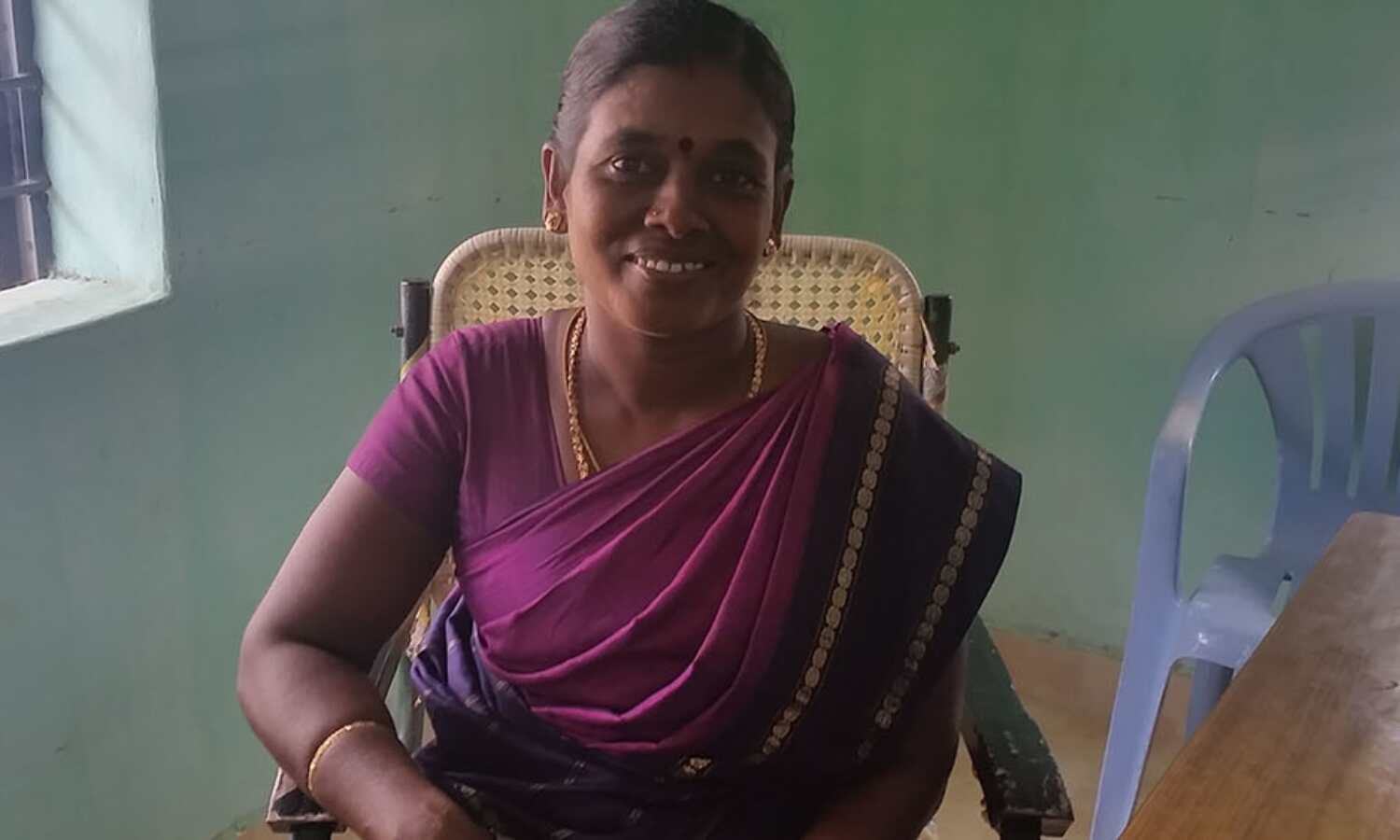
Rajanikandham, the dalit president of Nachangulam panchayat in Tamil Nadu’s Sivagangai district, has no assets. The state pays her an honorarium of Rs 1,000 a month, and she often ends up paying out of her pocket to visit the district collectorate for panchayat work. Having no fixed income affects dalit and adivasi women presidents disproportionately since they have to do a full-time constitutional role at the expense of their wages and employment.
Nachangulam Panchayat, Sivagangai district (Tamil Nadu): What is it like to do a full-time job without a salary? Especially if you are a dalit or an adivasi woman and your daily earnings sustain your family?
Ask Rajanikandham, a dalit daily wage worker, who heads the Nachangulam village panchayat in southern Tamil Nadu’s Sivagangai district. Her husband too earns daily wages and the couple have three children, one of whom is disabled.
A state-run, guaranteed rural job scheme like the Mahatma Gandhi National Rural Employment Guarantee Act (MGNREGA) is critical for poor families like these but as a panchayat head, Rajanikandham is not allowed to profit from it.
“I hold an office, I have power and prestige but no income. I get no salary from the panchayat and I can’t work for wages under MGNREGA because I am panchayat president,” she said. “All I have are three goats I got under a government scheme.”
In Tamil Nadu, panchayat presidents--an elected full-time constitutional role--are not paid any salaries. The only other states in India that do not pay a salary to its rural elected representatives are Maharashtra, Gujarat and Odisha.
Panchayat presidents in Tamil Nadu are paid an honorarium of Rs 1,000 to cover travel expenses and an additional Rs 100 for attending a meeting twice a month.
Compare this to the earnings of a member of the state’s legislative assembly (MLA)--after a recent 100% hike, he/she receives a basic monthly salary of Rs 1.05 lakh, apart from the several perks and pensions. The last time Tamil Nadu revised its honorarium for panchayat officials was in 2012, when it was hiked from Rs 300 to Rs 1,000. And the meeting fee was raised from Rs 50 to Rs 100.
This Rs 1,000 is barely enough to cover the panchayat head’s expenses for the mandatory weekly meeting at the block development office (BDO) or the regular trips to the district collectorate to lobby for extra funds for development projects and procure information about different government schemes.
In the first part of our series, we saw how Tamil Nadu’s women panchayat leaders were changing the face of rural governance. In the second part today, we investigate the financial challenge they face every day, especially dalit and adivasi women leaders: How to raise money for poorly funded development projects even as they struggle with poverty at home.
This is a problem male panchayat leaders face too but the honorarium system puts even greater pressure on women from marginalised communities. Like many working women, they also have to deal with social and familial pressures as they struggle to bring in extra resources for the panchayat. Unlike men, they cannot spend long hours away from home, lobbying for funds with the male-dominated network of higher officials.
“For women, taking a day out and travelling to the district collectorate periodically and spending an entire day there is difficult,” said Rajeswari, of Kuruthangudi panchayat (Kalaiyarkovil block) in Sivagangai district, who belongs to the Parayar community. “They have to answer so many questions from their families and society. We are often asked, ‘What is the need to go out so often and come back late?’”
Women leaders also have to deal with insults and slander for being out of their homes and travelling. “Earlier, posters of women (leaders) would be put up in villages calling them ‘characterless’ for staying out late for panchayat work. Things got a bit better after the state government gave strict orders to district collectors to ensure that only women attended meetings and not their male relatives,” said G Uma, assistant professor in the gender department at Indira Gandhi National Open University (IGNOU), who has researched on women in Tamil Nadu’s panchayat governance.
Yet, when women had to choose between a regular salaried job and the power to make a change, IndiaSpend found many opting for the latter.
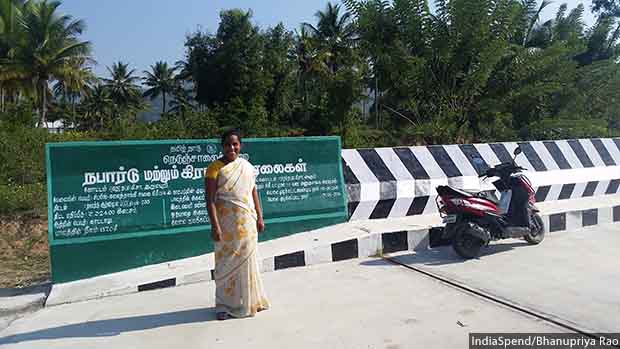
Tenmozhi, the president of Sitilinghi panchayat in the reserved forests of Tamil Nadu’s Dharmapuri district, gave up a job offer from the state’s electricity board to fulfil her constitutional role as an elected representative. When women had to choose between a regular salaried job and the power to make a change, IndiaSpend found many women panchayat presidents opting for the latter.
Tenmozhi, a maths graduate from the tribal Malayali community who featured in our series last year, declined a job offer from the Tamil Nadu Electricity Board because she was just elected the president of her panchayat and wanted to set the agenda for change.
50% of dalit women panchayat heads are daily wage workers
The state bars panchayat presidents from holding a paid employment or any job that receives government funding, such as employment under MGNREGA, to avoid conflict of interest.
But consider what this means to women whose families survive on daily earnings. In our survey of 32 panchayats headed by women in six districts of Tamil Nadu, we found that dalit and adivasi women came with almost no assets and meagre family incomes.
Six of the 12 dalit women we interviewed were daily wage workers with no assets at all. The other six were slightly better off, owned between 1-5 acres of lands. Two of the three adivasi women lived in a one-room tenement, and subsisted on either daily wage work or collecting forest produce. In contrast, women from the dominant castes such as Thevars, Gounders and Vanniyars had family ownership of lands ranging from 10 acres to 30 acres.
For those who worked in private jobs, there were other kinds of problems. Dalit women panchayat leaders from the Arunthatiyar community, who mostly earned their living from daily wage work on farms owned by dominant castes like Thevars and Gounders, had a particularly difficult time managing with meagre resources.
Taking time off their daily wage work to travel on official business to various district and block offices means loss of the day’s wages, which is not compensated in any form by the panchayat.
To add to all this, a panchayat leader is expected to serve refreshments for visiting government officials. Often, they are also expected to refuel the vehicles of the visiting government staff.
“A visiting engineer who prepares plans and estimates for civil works or a visiting deputy BDO (block development officer) often demands that the president pay for their fuel. These lower level bureaucrats have fuel limits set by the government,” said IGNOU researcher Uma.
IndiaSpend saw these problems first hand when we visited a panchayat where a block-level official insisted that the president arrange refreshments despite our protests. She ended up spending Rs 300 out of her pocket.
In Dindigul district, George Dimitrov, a lecturer in Gandhigram Rural University, who has researched and documented all the 25 dalit women presidents, found that 11 women from the Arunthatiyar community worked as daily wagers in the farms of dominant caste landholders. A lack of salary affects their autonomy and makes it difficult for them to resist the demands of their employers.
Saroja heads the Kakkadasam panchayat in Krishnagiri district but it is her husband who actually controls it. For her, MGNREGA is more than just work. “I wanted for this term to end soon so I can go for MGNREGA work. I feel like a slave in this household,” Saroja said. “MGNREGA work gives me the freedom and a community of women I can talk to. This job has snatched away my freedom without giving me any real power.”
Tamil Nadu’s neighbouring state, Kerala, pays its panchayat leaders Rs 13,200, the highest in the country. Telangana has recently revised the salary to Rs 5,000 while Andhra Pradesh and Karnataka have revised it to Rs 3,000.
| Income Of Panchayat Presidents In Some Indian States | ||
|---|---|---|
| State | Salary | Honorarium |
| Goa | 4000 | |
| Maharashtra | 1000 | |
| Gujarat | 500 | |
| Jharkhand | 1000 | |
| Bihar | 2500 | |
| West Bengal: | 3000 | |
| Odisha | 1000 | |
| AP | 3000 | |
| Telangana | 5000 | |
| Karnataka | 3000 | |
| Kerala | 13200 | |
| Tamil Nadu | 1000 | |
| Haryana: | 3000 | |
| HP | 3000 | |
| Punjab | 1200 | |
| Uttar Pradesh | 3500 | |
Source: Data collected from state panchayat raj department websites
Mobilising resources: How women manage despite odds
As we reported in the first part of this series, women leaders were going beyond their assigned duties--such as provision of drinking water, sanitation, streetlights, road repair--to invest in services which have been neglected by their male predecessors.
But mobilising extra funds is difficult because of how Tamil Nadu’s panchayat finance is structured. The panchayat has three revenue sources:
- Own revenues, collected by the panchayats themselves;
- Devolved funds, from the Centre and the state based on the formula assigned by the central and state finance commissions, respectively;
- Assigned revenues, from taxes collected by the state for efficiency, but assigned entirely to panchayats.
Own revenues, over which panchayats have complete control, constitute only 10% of the total revenues, as per our analysis. These are mainly from the taxes that panchayats can levy on their residents--house tax, profession tax, water tax, advertisement tax and some licenses and fees.
In a micro study of three villages in Tamil Nadu, Anand Sahasranaman of Institute of Financial Management Research (IFMR) Trust estimated that this own revenue is usually sub-optimal: It makes for only 0.15% to 0.2% of the total village income.
Rates of house tax--the largest source of own revenues--have not been revised in many years and are kept flat irrespective of the size of properties. Poor households actually end up subsidising rich ones. If panchayats were to increase their tax collection to even 2.5% of village incomes, their own revenues would increase by 15 times, calculated Sahasranaman’s study.
The state government has also abolished matching grants to the house tax collected, an incentive for better tax collection.
Panchayats, thus, have to depend on devolved grants and pooled assigned revenues, which form two-thirds of the total revenues.
Based on the fourth State Finance Commission (SFC) (2012-2016) recommendations, the state government designated 10% of the state tax revenues as grants to urban and rural local bodies in the ratio of 42:58. Gram panchayats are assigned 60%, the highest among the three tiers of rural governance.
But even while the state government increased the SFC grants, ‘untied funds’ that can be used freely, from 8% in 1997 to 10% in 2012, it imposed a more complex system of bureaucratic approvals on them. For instance, 10% of the SFC grants due to panchayats are now reserved for Infrastructure Gap Filling Fund, which is under direct control of the district collector.
Every panchayat in Tamil Nadu gets a uniform SFC grant of Rs 3 lakh (revised down from Rs 5 lakh after enhanced revenues from the 14th Central Finance Commission in 2015) and an added grant based on the population. A panchayat of 2,000 population gets anywhere between Rs 5 lakh and Rs 8 lakh annually from the devolved SFC grants.
This finance architecture, while being the same for all panchayats, affects those headed by women more.
Large development projects require massive capital outlays, which materialise after lobbying for a number of years. Tenmozhi, as we reported in our earlier series, had to lobby with the Centre for two years for a Rs 30-crore grant to build a bridge connecting 5,000 people from seven villages.
‘I had to struggle for everything’
Lobbying demands time, effort and access to officials of the district collectorate. Women have a tougher time investing in these.
Rajeswari of Kuruthangudi panchayat is popular in her district for her skills in mobilising funds for various schemes. But for a Parayar dalit, it did not come easy. She recounted her story:
“I had to struggle for everything--ration shop, school, library. We have no funds to build these. Most of the big scheme funds as well as NABARD (National Bank for Agriculture and Rural Development) funds are handled by the assistant director of panchayats. We need to regularly show our face to get funds. Men go directly to him, sit with him for a long time and ensure funding. We can’t.”
Rajeswari has been able to manage the time and expenses for travel because of a supportive family and a husband who holds a government job. But this is not the story of other dalit and adivasi women presidents.
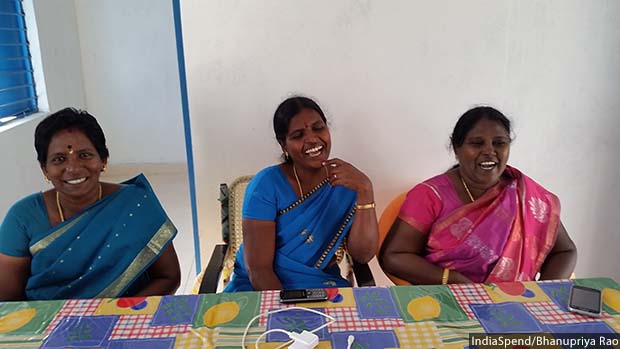
Mazharkodi Dhanasekar (left) of Melamarungoor panchayat is from a dominant caste, and her family owns 15 acres of land. She spent Rs 1 lakh of her own money to build toilets under Swachh Bharat Abhiyan. Leaders such as Prema (centre) and Rajeswari (right), dalit presidents of Kurthangudi and Silakkapatti panchayats, have to lobby hard for funds. This takes time, effort and access to officials--easier for their male counterparts.
Even self-employed women like Prema, the president of Silakkapatti panchayat in Sivagangai district who runs a small general store in her village, has a tough time because shutting shop means loss of business.
Other important sources of funding like MLA and MP funds and funds from district and block panchayat unions (additional tiers of local governance) need political access to male-dominated networks. This, women leaders said, is hard work especially for first-timers. Although panchayat leaders are not supposed to be affiliated to political parties, such affiliations are now common and, often, determine funding.
Manjula, who heads Mallachandaram panchayat (Thally block in Krishnangiri district), managed to get public works worth Rs 26 crore sanctioned. This included a brand new high school building, several roads, and a ration shop. It is not lost on her that this was possible her husband is a member of the district unit of All India Anna Dravida Munnetra Kazhagam (AIADMK).
“MLAs as well as district and block chairpersons prioritise party loyalists. Here, if you are from the AIADMK, there is greater chance of getting more funds,” she said. “Also MLAs allocate certain amount for each block so they can fund only a few panchayats. So we have to be seen constantly when they are in their constituency to get attention.”
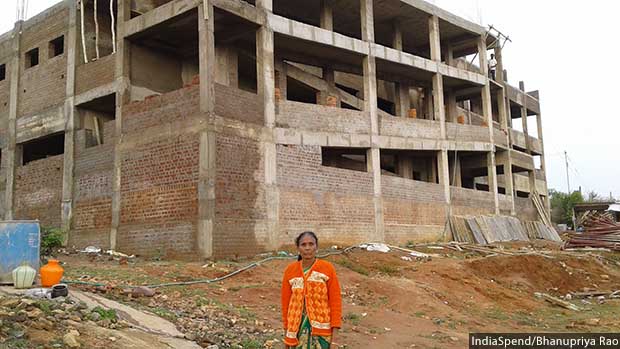
Manjula, the president of Mallachandaram panchayat in Tamil Nadu’s Krishnagiri district, managed to get public works worth Rs 26 crore sanctioned. It is not lost on her that this was possible her husband is a member of the district unit of All India Anna Dravida Munnetra Kazhagam. Leaders who are party loyalists have better chances of getting funds allocated from members of legislative assembly and parliament.
Mazharkodi Dhanasekar, the feisty president of Melamarungoor in Sivagangai district whose campaign against open defecation we featured in our last series, had to spend Rs 1 lakh of her own money to build toilets under the Swachh Bharat Scheme. As a member of the dominant Maravar community, a subcaste of the Thevars, whose family owns 15 acres of land, it was easier for her.
“I could do it because we are financially well off and my husband did not object,” she said. “Many women neither have the money nor the independence. We need more funds to build necessary infrastructure.”
Women leaders are bullied by upper-caste employers
Since 2006, panchayats in Tamil Nadu have seen greater bureaucratisation, with increased government control and shrinking autonomy. Autonomy over funds that are necessary for routine maintenance works, such as repair of streetlights, have been tightened. Lower-level block officials are now assigned to exercise greater control over the panchayats.
“Earlier, the BDO was only advising the presidents. Now the deputy BDO has greater control,” said Kalpana Satish, who has trained women panchayat presidents and worked with the Federation of Women Panchayat Presidents. “Panchayat presidents cannot sign cheques without their permission. Even for untied funds, presidents have to make a proposal and send to the BDO and wait for his approval.”
As per Tamil Nadu Panchayat rules, presidents can spend upto Rs 600 for repairs to hand pumps and Rs 7,500 for motor pump maintenance without an approval from engineers. Presidents are allowed upto Rs 2,000 at a time or Rs 5,000 a year for urgent public works without any technical approval. This is grossly inadequate, said women leaders.
“Everyday there is some problem with pipelines, motors and their maintenance. Is Rs 2,000 enough?” asked Thulasimani (30), the dalit president of Koombur panchayat in Dindigul.
Thulasimani has often been the target of casteist attacks from the upper-caste Gounder men because she dared to sit on the president’s chair.
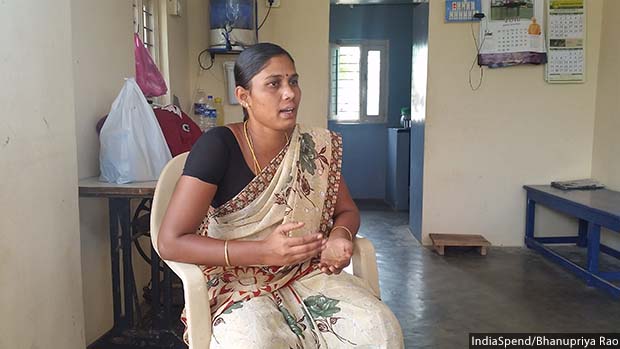
Thulasimani, the dalit president of Koombur in Tamil Nadu’s Dindigul district, has often been the target of casteist attacks from the upper-caste Gounder men. Presidents are allowed upto Rs 2,000 at a time for urgent public works without any technical approval. Since 2006, panchayats in Tamil Nadu have seen greater bureaucratisation, with increased government control and shrinking autonomy. Lower-level block officials are now assigned to exercise greater control over the panchayats.
“When we get calls from people, especially upper castes, to repair a motor pump, we don’t have the time to wait for estimates and approvals. We have to repair then and there,” she said. “Sometimes we get credit, but many times we even have had to borrow at an interest from moneylenders.”
Despite all these structural challenges, women are delivering beyond the basic services and this is not because of the system, but in spite of it. Tamil Nadu’s finance system for local governance is a classic example of how systems are designed without envisioning the roadblocks they present to the most marginalised groups.
This is the second of a five-part series on women panchayat leaders in Tamil Nadu. You can read the first part here, the third part here, the fourth part here and the fifth part here.
Next: Why Muthukanni, A Dalit, Had To Build Her Own Panchayat Office
(Rao is a co-creator of GenderandPolitics, a project which tracks women’s representation and political participation in India at all levels of governance.)
We welcome feedback. Please write to respond@indiaspend.org. We reserve the right to edit responses for language and grammar.


